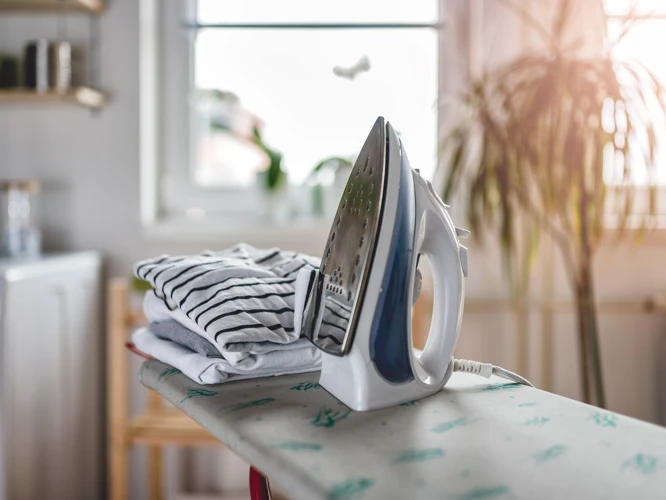It’s a common mishap: you’re ironing a patch or hemming a garment, and suddenly, there’s a mess on your iron. Glue or adhesive from fusible interfacing melts onto the soleplate, leaving you with a sticky situation. Understanding how to remove glue from iron can save you from frustration and extend the life of your iron, ensuring your clothes remain unmarred by unwanted residue.
The Challenge of Sticky Residue on Iron
Sticky residue is not just annoying; it can transfer to your favorite fabrics, causing further damage. Addressing the issue promptly can help prevent this. By using the right iron cleaning tips, you can restore your iron’s smooth surface for effortless gliding over any material.
Understanding the Iron’s Surface
The soleplate of your iron is crucial for its performance, and keeping it clean is essential for its longevity. Knowing the type of surface you’re dealing with is the first step in effective glue residue removal.
Types of Iron Soleplates
Iron soleplates come in a variety of materials, including stainless steel, ceramic, nonstick, and titanium. Each type might require a slightly different approach when cleaning. However, the foundation of how to clean an iron remains similar across the different types.
Preparation: Before You Start the Glue Removal Process
Set yourself up for success by gathering the appropriate materials before attempting to clean your iron soleplate. Proper preparation can make the process smoother and more effective.
Materials You Will Need for Iron Cleaning
- Distilled white vinegar
- Baking soda
- Clean cloth or towel
- Old toothbrush (optional)
- Wooden or rubber spatula (optional)
DIY Iron Cleaning Steps
Now that you’ve prepared, follow these steps to ensure a safe and thorough cleaning process. These DIY iron cleaning solutions will help you tackle the sticky challenge without resorting to harsh chemicals.
Step 1: Safety First
Ensure your iron is unplugged and completely cool before you begin. This precaution not only protects you from burns but also prevents any cleaning solutions from reacting with a hot surface.
Step 2: Initial Cleaning Iron Surface
Gently wipe the iron’s surface with a damp cloth to remove any loose debris. If the glue is still soft, you may be able to gently peel it off using a wooden or rubber spatula, taking care not to scratch the soleplate.
Step 3: Non-Toxic Glue Removal Techniques
For a non-toxic glue removal approach, create a paste with equal parts of distilled white vinegar and baking soda. Apply the paste to the affected area and let it sit for a few minutes. Then, gently scrub with a clean cloth or a toothbrush and wipe clean.
Step 4: Dealing with Stubborn Glue Residue Removal
If the paste doesn’t do the trick, you can heat the iron to its lowest setting and run it over a clean towel sprinkled with salt. The combination of heat and mild abrasion should help lift the glue off the soleplate. Always ensure the iron cools down again before touching it.
Step 5: Final Touches for a Clean Iron Soleplate
Once the majority of the glue is gone, give your iron one last wipe with a cloth dampened with distilled water to remove any remaining cleaning residue. Your goal is a clean iron soleplate that looks as good as new.
Alternative Methods for Removing Glue from Iron
While DIY methods are effective for many, sometimes you may prefer alternative cleaning options. Here are a couple of other methods to consider.
Using Commercial Iron Cleaners
Commercial iron cleaners are formulated to tackle tough stains and residues. Follow the instructions on the product, and always test on a small area first to ensure it doesn’t damage the soleplate.
Home Remedies for Iron Cleaning
Another home remedy involves using a damp cloth with a small amount of toothpaste. Rub the cloth on the cool soleplate in a circular motion, and then wipe clean. Toothpaste can act as a mild abrasive, aiding in glue residue removal.
Maintenance: Household Iron Maintenance Tips
Regular maintenance is key to preventing sticky situations. By implementing a few household iron maintenance tips, you can keep your iron in top condition.
Regular Cleaning to Prevent Sticky Residue
- After each use, wipe the soleplate with a clean, damp cloth.
- Once cooled, store the iron in an upright position to avoid accidental damage to the soleplate.
- Periodically do a deeper clean with vinegar and baking soda to maintain a pristine surface.
Conclusion: Ensuring Your Iron Remains Clean and Functional
Achieving a clean iron soleplate is an attainable goal with the right approach. Whether you use DIY iron cleaning methods or commercial products, the key is consistency and proper care.
Dealing with stubborn glue on various surfaces can be a challenging task, but with the right techniques, it’s manageable. If you’re specifically looking to remove glue from an iron surface, our article on how to get glue off iron will provide you with the guidance you need. For those facing similar sticky situations on other materials, we have helpful guides for different surfaces as well. Discover how to tackle adhesive residue with our articles on how to get glue off brick, how to get nail glue off metal, and how to get glue off granite. Each guide is tailored to address the unique challenges posed by the respective material, ensuring you can restore your surfaces to their former glory.
Summary of Iron Cleaning Tips
In summary, to remove glue from iron, start with safety in mind and choose the best cleaning method for your iron’s soleplate. Regular maintenance and prompt attention to any sticky residue on iron will keep your appliance performing well for years to come.


